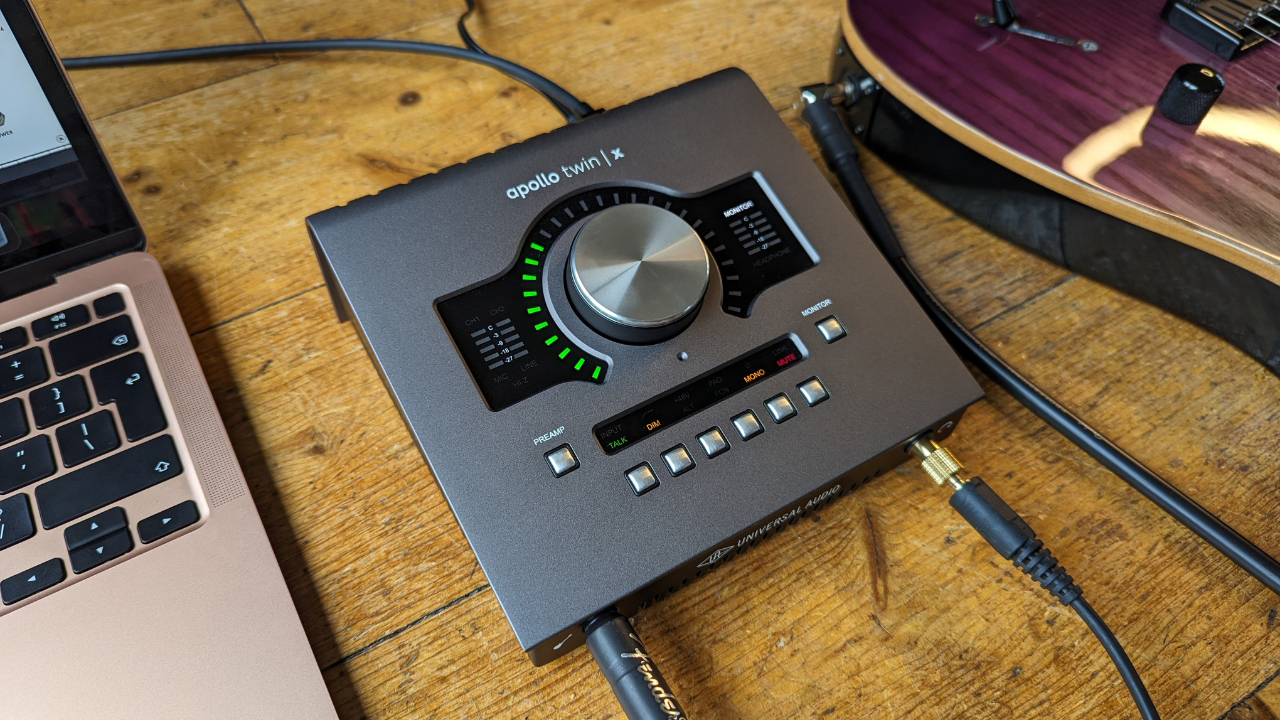
It’s interesting how we guitarists spend so much money to get our hands on gear that emulates fifty-year-old technology. We dedicate our playing time to achieving the tones and techniques of players long gone or past their prime, while manufacturers use every modern tech trick in the book to recreate the sounds and vibe of whichever vintage yesteryear. I can’t think of many other categories of technology where this is the case, and I’ve yet to see anyone harking for the day floppy disks return so they can store their data the way they used to.
The Universal Audio Apollo Twin X is one such piece of gear. On the one hand, it’s a thoroughbred modern audio interface with duo/quad SHARC DSP processors, advanced AD/DA conversion, and some incredible dynamic range and total harmonic distortion figures. On the other, the actual workflow is decidedly nostalgic, aiming to recreate the process of recording via an analog studio desk, using plugins modeled on vintage rackmount units from the '60s onwards.
It’s a premium bit of kit from the build quality to the price tag but for those who just want to record guitars at home, is it a little bit too much? With so many guitar audio interfaces available these days, how can it justify costing more than double some of its rivals from Focusrite, Native Instruments, and Audient? I got hands-on to find out…
Universal Audio Apollo Twin X review: Features

My review model is the Quad SHARC DSP processor-equipped model, but there is a Duo version that halves the processors and is slightly cheaper if you don’t feel you’ll need that much firepower. Both units are exactly the same otherwise, featuring two combi inputs on the rear with a dedicated guitar input on the front alongside a headphone out. You also get two outputs for studio monitors, two line outs, and an optical in for expanding your connectivity to up to ten inputs.
There’s a really reassuring and hefty weight to the Apollo Twin X unit itself, and it comes nicely boxed in a luxurious foam. The all-metal chassis gives it a very robust feel with the encoder knob and buttons feeling rock solid. It’s got premium written all over it, which is reassuring with the amount of money it costs. Inside the box, you’ll find a laptop-style power cable that locks with a twist to prevent any accidents but bizarrely, there is no Thunderbolt cable to connect it to your computer. This means you’ll have to purchase your own separately or use one you already have – more on which later.
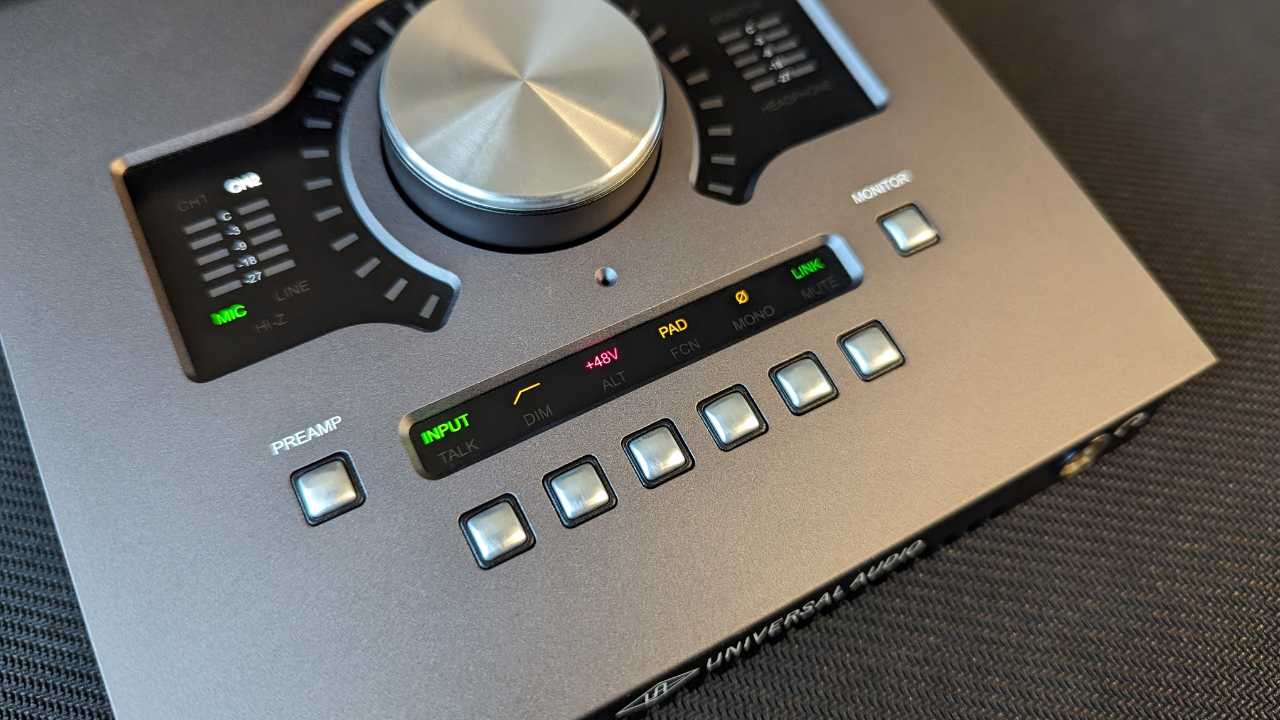
On the front panel, you get a large rotary encoder that controls the input and output levels depending on which button you press. A preamp button to the left allows you to change which channel you’re using, whilst the monitor button opposite switches between your studio monitors and headphones.
Slightly below that you have six buttons which in preamp mode control the input type, low cut, phantom power, engage a pad, switch the polarity, or link the two mic preamps. Switch to monitor mode and they let you control the talkback mode, a ‘dim’ function that drops the output by 20dB, mono operation for your monitors and headphones as well as a mute function.
Universal Audio Apollo Twin X review: Installation

Getting everything out of the box and plugged in on my desk, I run into the first of a few snags. My third-party Thunderbolt 4 cable doesn’t quite fit due to the way the socket is recessed into the unit. The round shape of the recess blocks the square shape of the cable connector surround, which meant I had to order a different cable with a lower profile connector that would fit. It’s one of the worst feelings when you get a new piece of gear only to discover you can’t use it right away!
The next day, with a fresh cable at the ready - cheers, Amazon Prime next-day delivery - I proceeded to get everything set up by hooking the interface up to my MacBook Air M1. As a former computer repair shop technician, I’ve run into a fair few issues with computers before, but the installation process here is one of the most labyrinthine I’ve undertaken in a long time.

Be prepared to spend some time rebooting your Mac, enabling startup options, and going through multiple accessory connection requests before you can even think about plugging in your guitar. I stumbled quite a few times here, having to restart the whole process again as I accidentally canceled or missed a step. Once I got past all the stages required to complete installation, I had to wait even longer while a firmware update was installed to bring my unit up to scratch.
This extended installation process is a fault of the Silicon chip-equipped MacBooks rather than Universal Audio themselves, but I can’t help but compare it to the Focusrite Scarlett 4th Gen units I recently reviewed. Both of which quite literally had me up and running within minutes. Still, installation is just one aspect of the product and with it done and the UA Console app up and running, I proceeded to move on and get stuck into some actual recording.
Universal Audio Apollo Twin X review: Usability
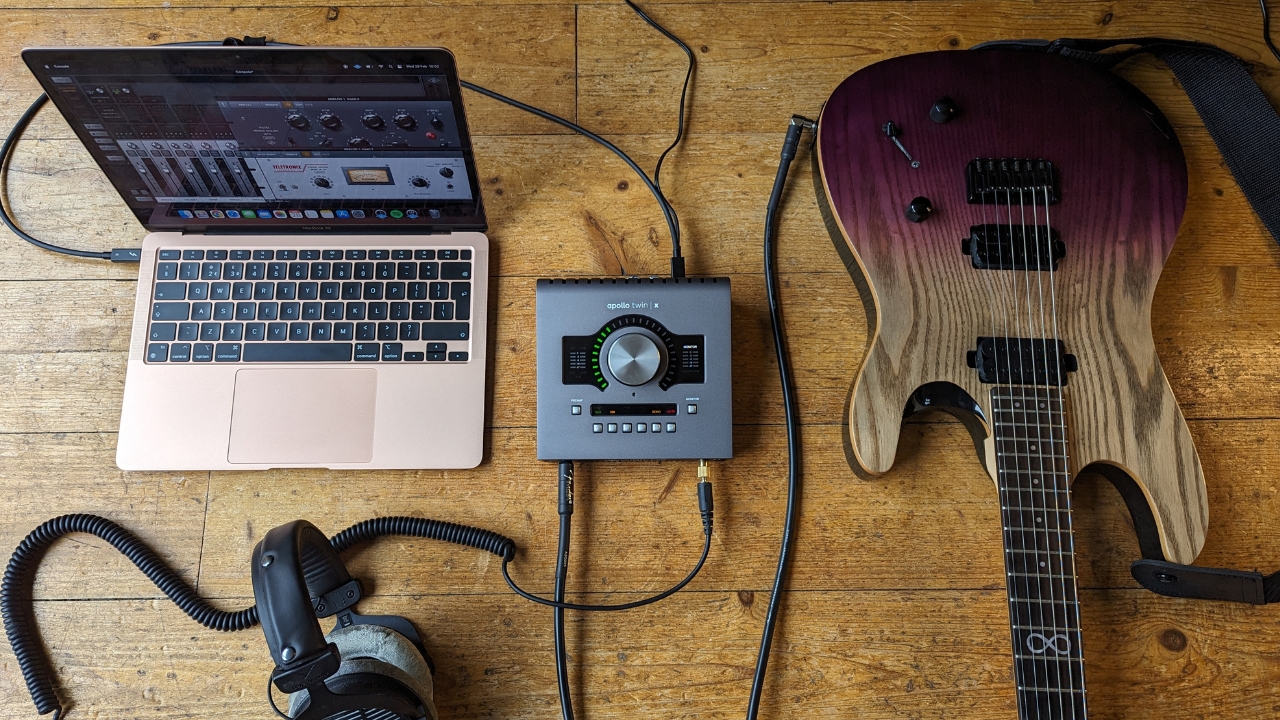
Loading up my preferred DAW Pro Tools and plugging in my current weapon of choice the Chapman ML-1 baritone guitar alongside my trusty Line 6 HX Stomp amp modeler, I began my review process by recording a demo for a new song that I’m working on for my band. Handily Pro Tools recognizes the interface immediately, so I’m off to a flying start following that convoluted installation.
The core of the recording experience with the Apollo Twin X lies in its console software. Here you’ll find an easier way to control the interface, plus access to all of the DSP-powered plugins from Universal Audio. The idea is much like what you’d do in a real recording studio, which is to get the best possible tone going in, rather than fixing it in the mix. You can load up your typical studio tools like channel strips, preamps, compressors, limiters, and EQs, shaping the sound before you hit the record button.
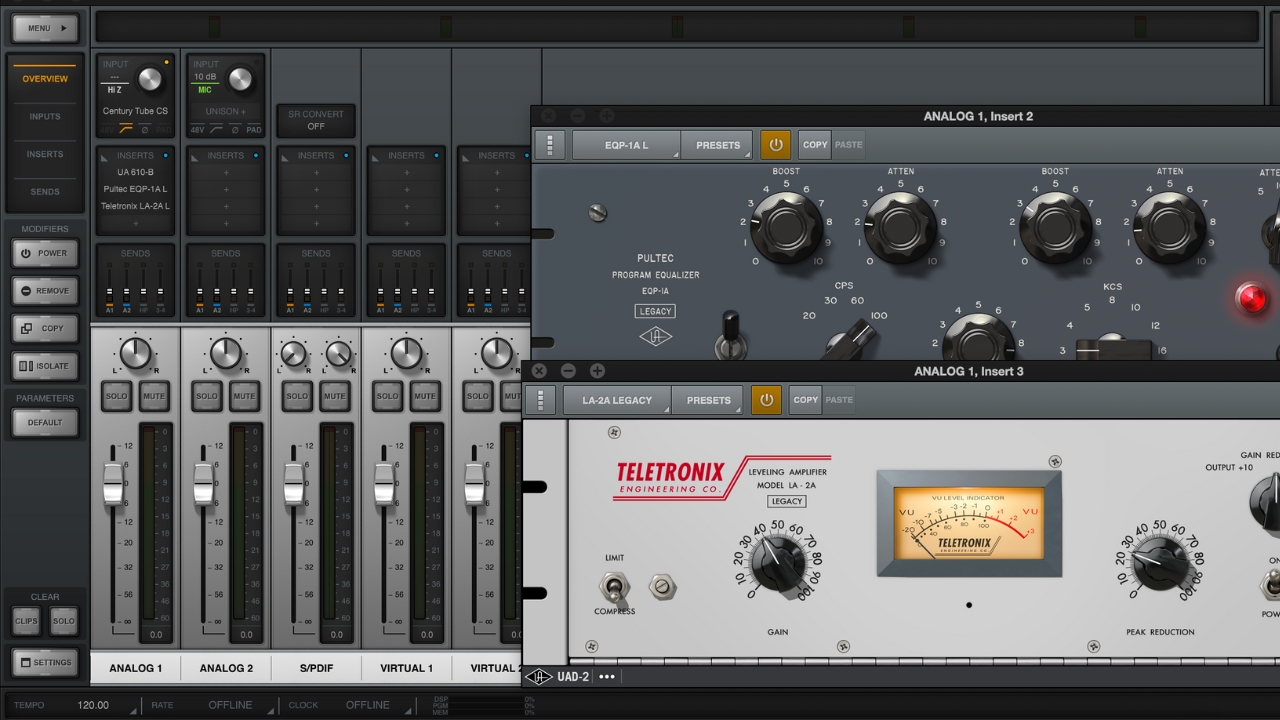
At the top of your channel is your input volume and type, which reacts to any inputs you make on the interface itself in real-time. Below that you have your Unison slot, which allows the Apollo to emulate any number of vintage and modern preamps. More importantly for this particular use case, it can also emulate a number of different guitar amps, including models from Fender, Marshall, Diezel, ENGL, Friedman, Ampeg, and Suhr models provided by Brainworx.
I really enjoyed the Fender Tweed model but was a little underwhelmed by the rest of them, much preferring the sound of my HX Stomp models and York Audio IRs. It may just be that these models need some tweaking to get them to sound their best, as is usually the case when it comes to dialing in realistic tones via amp modeling. What was much more useful was being able to add preamps or channel strips in real time and see how they beefed up the sound of my existing amp models.
There’s a lot to dive into here and loads of presets to get you going, including many knocked up by award-winning pro engineers like Richard Chycki and Andrew Scheps. All of the UA plugins are initially available on a 14-day trial so you can use everything but rather annoyingly, once you finish the trial they don’t disappear, which can make it difficult to remember which ones you own and which you don’t. There’s also no way to categorize your plugins, so you’ll have to rely on memory if you plan on frequently using them in this way.
Doing things this way is certainly refreshing to the usual approach I'd take, ironing out inconsistencies later on in the recording process. It's much closer to the process of actual studio recording, where your guitar will be sent through multiple pieces of outboard gear and then into a desk before finally landing in the DAW. It requires experimentation, but ultimately I found it an extremely rewarding way to lay down my guitar tracks.
Universal Audio Apollo Twin X review: Sound
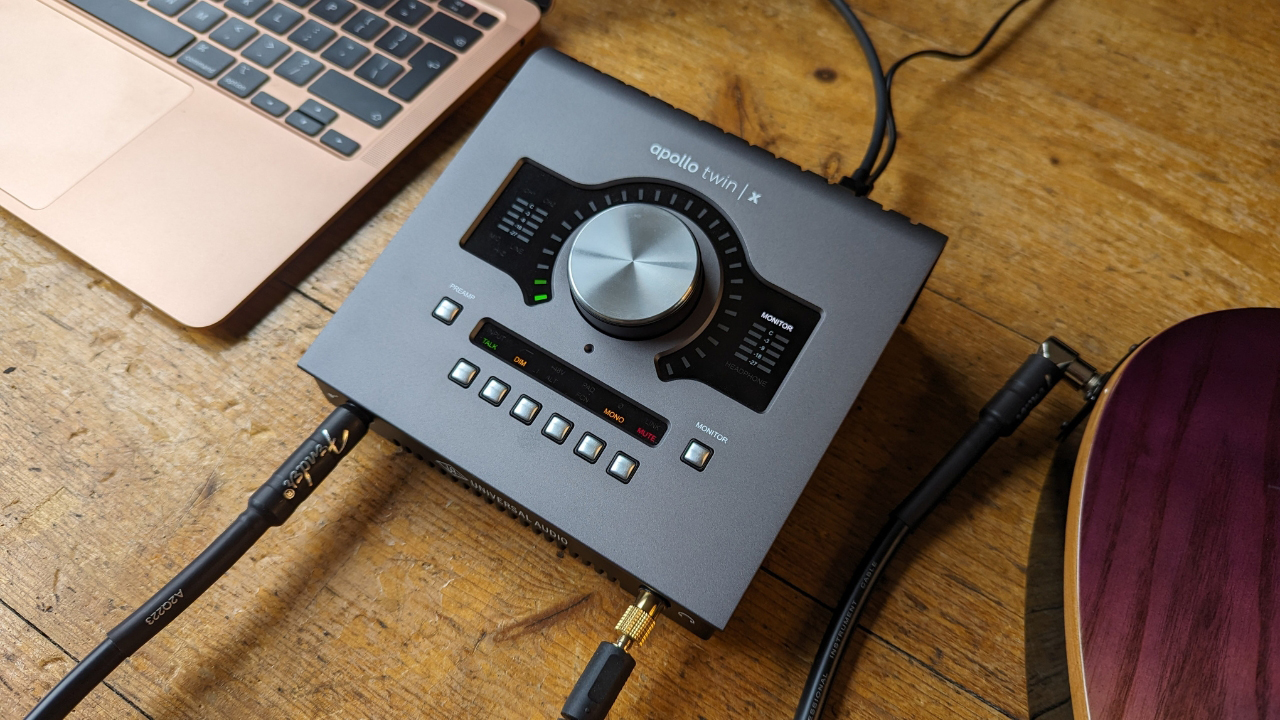
To the more subjective matter of sound, I’ll often test a new audio interface by running some of my favorite songs at a good volume through my studio monitors. Cueing up my favorite mix reference playlist, I immediately noticed that the Apollo drives my speakers a lot harder than any other interface I’ve tested. Even at a quarter of the way up on the monitor output I get more volume than when I’m halfway turned up on the Focusrite Scarlett 4i4 4th Gen.
Is it objectively better though or just louder? I’d wager there’s not much difference between the Apollo or any other decent audio interface when it comes to the actual sound quality you get out of it. With any audio interface, you get what you put in, and the quality of the sound is at the behest of the person twiddling the knobs and the player laying down the tracks, rather than the gear you use.
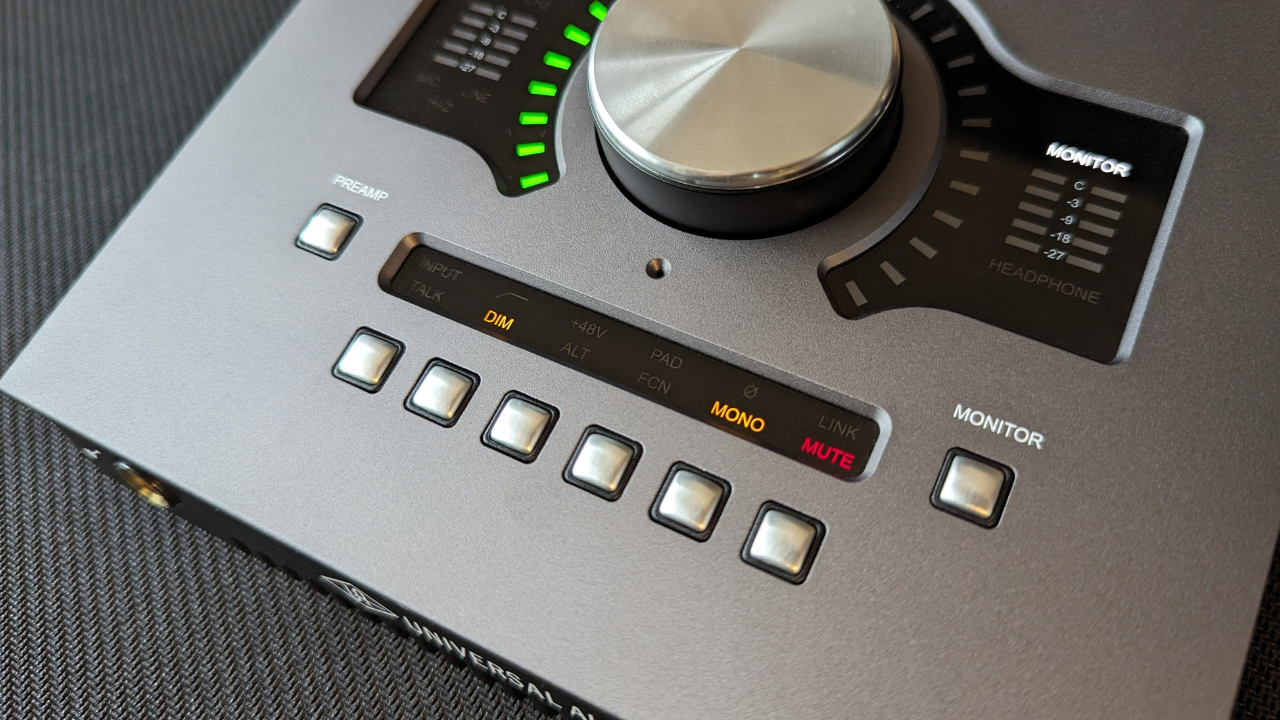
Utilizing the mic preamps with an SM57 and a condenser mic on a guitar cab can lead to some fantastic sounds, giving you the best possible chance of nailing a quality recording if you like to do things old school. The ability to change the character of the preamp gives it a huge advantage over many of its competitors too, as you can chop and change depending on your guitar pickups or just stick with your tried and trusted sonic characteristics.
I got some searing guitar tones out of my HX Stomp with the Apollo, which combined nicely with a DI bass guitar and a drum VST to create my final demo. Would I have gotten a similar sound with a different interface? Probably, but where the Apollo Twin X excels is in encouraging that analog approach to recording guitars. The fact that the interface takes the CPU load away from your computer is incredibly useful, as it gives more flexibility to those with less powerful machines. Simply put it gives you more options, which is always a good thing when crafting your own recordings.
Universal Audio Apollo Twin X review: Verdict
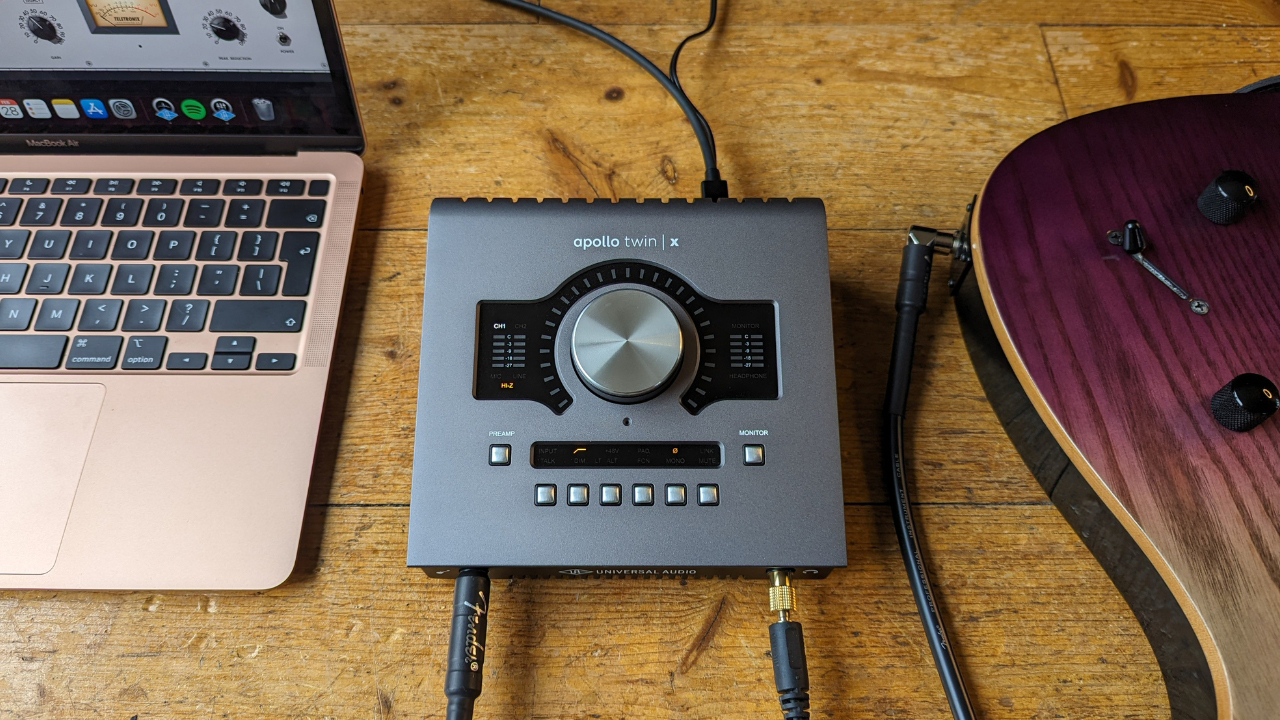
There’s a reason many pro engineers use the Apollo Twin X as their home or travel audio interface. The workflow is sleek and smooth (once you get it installed) and the power of DSP processing takes the strain off your computer, freeing you up to get into more complex projects. An excellent feature set makes it a powerful tool for recording guitars, and there’s plenty to grow into should you decide to upgrade your setup in the future.
Is it worth the investment for the guitarist recording direct at home? It all depends on your use case. If you just want to demo simple riffs and licks, we’d look elsewhere for something cheaper. If you want to do more complex, full song arrangements with other instrumentation or get into recording with real-world amps and microphones, then the Universal Audio Apollo Twin X is totally worth the asking price.
Universal Audio Apollo Twin X review: Specs
- Simultaneous I/O: 10 x 6
- A/D Resolution: 24-bit/192kHz
- Built In DSP/FX: UAD-2 Quad Core Processing, Realtime UAD Powered Plug-ins
- Number of Preamps: 2 x mic, 1 x instrument
- Phantom Power: Yes
- Analog Inputs: 2 x XLR-1/4" combo (mic/line), 1 x 1/4" (Hi-Z)
- Analog Outputs: 2 x 1/4" (monitor), 2 x 1/4" (line out)
- Digital Inputs: 1 x Optical Toslink (ADAT,S/PDIF)
- Headphones: 1 x 1/4" TRS
- Software: UAD Realtime Analog Classics plug-ins (VST, AU, AAX 64), 5 Heritage Edition plug-ins
- OS Requirements - Mac: macOS 10.12 or later, Quad Core i7 Processor or higher
- OS Requirements - PC: Windows 10 Anniversary update or later, Quad Core i7 Processor or higher
- Power Supply: 12V DC power supply (included)
- Weight: 2.35 lbs.
- Contact: Universal Audio







